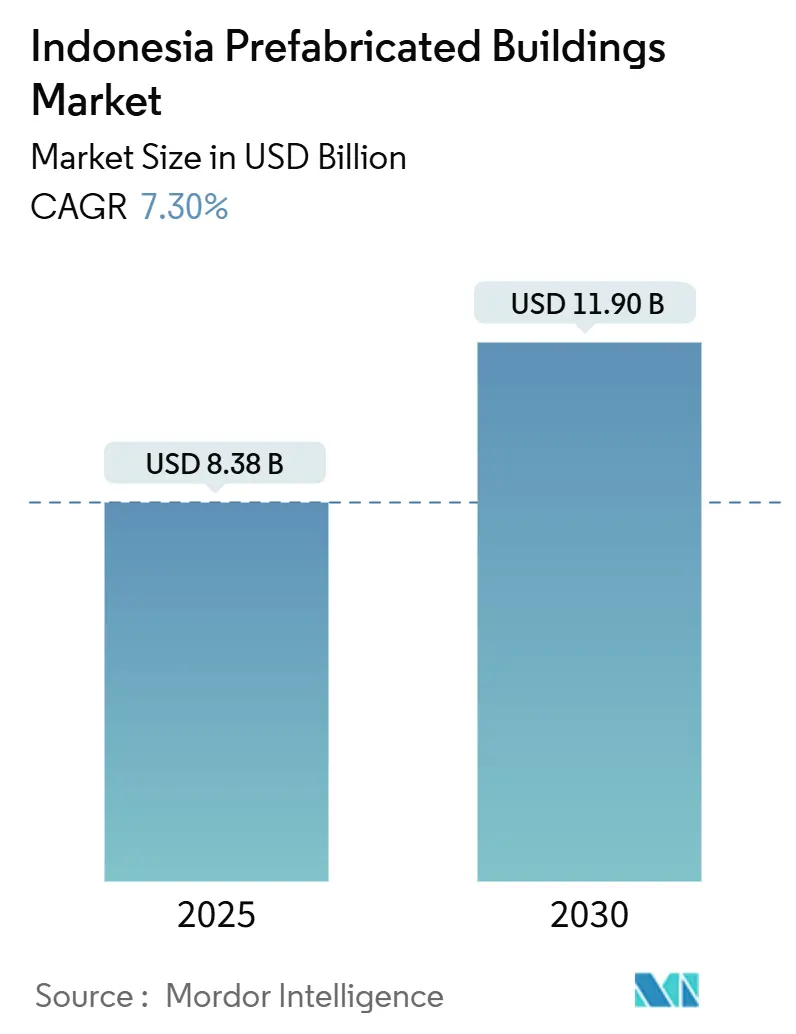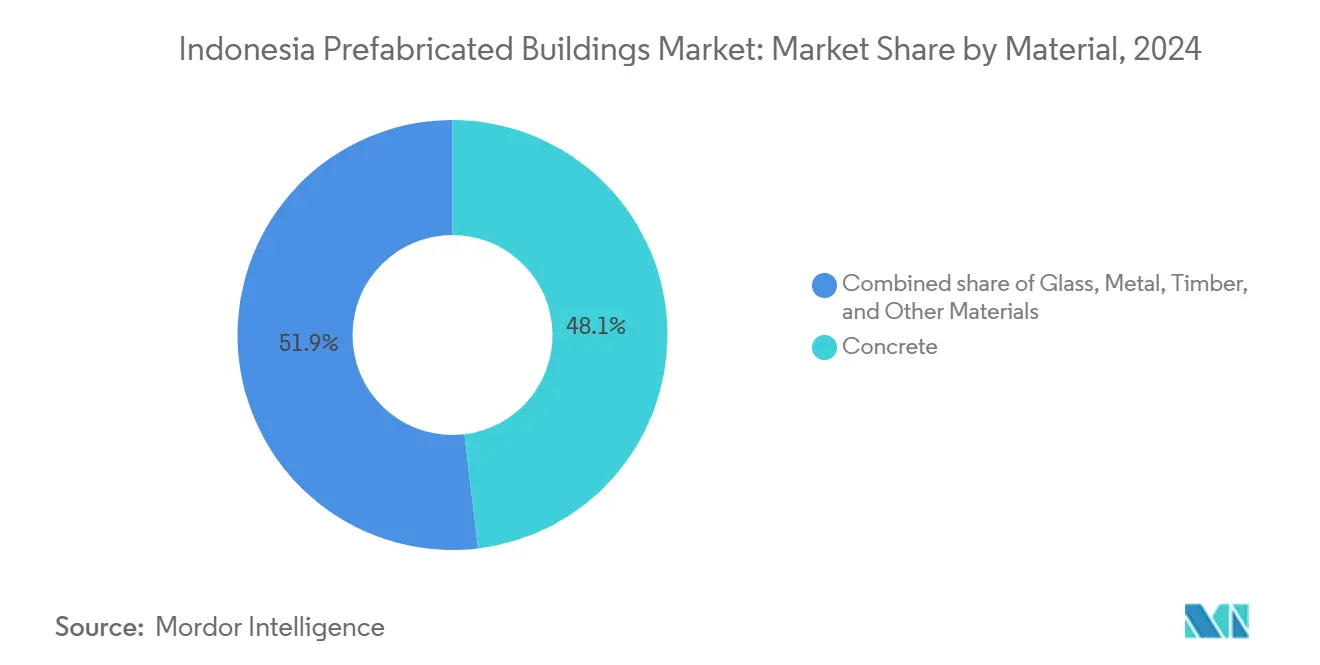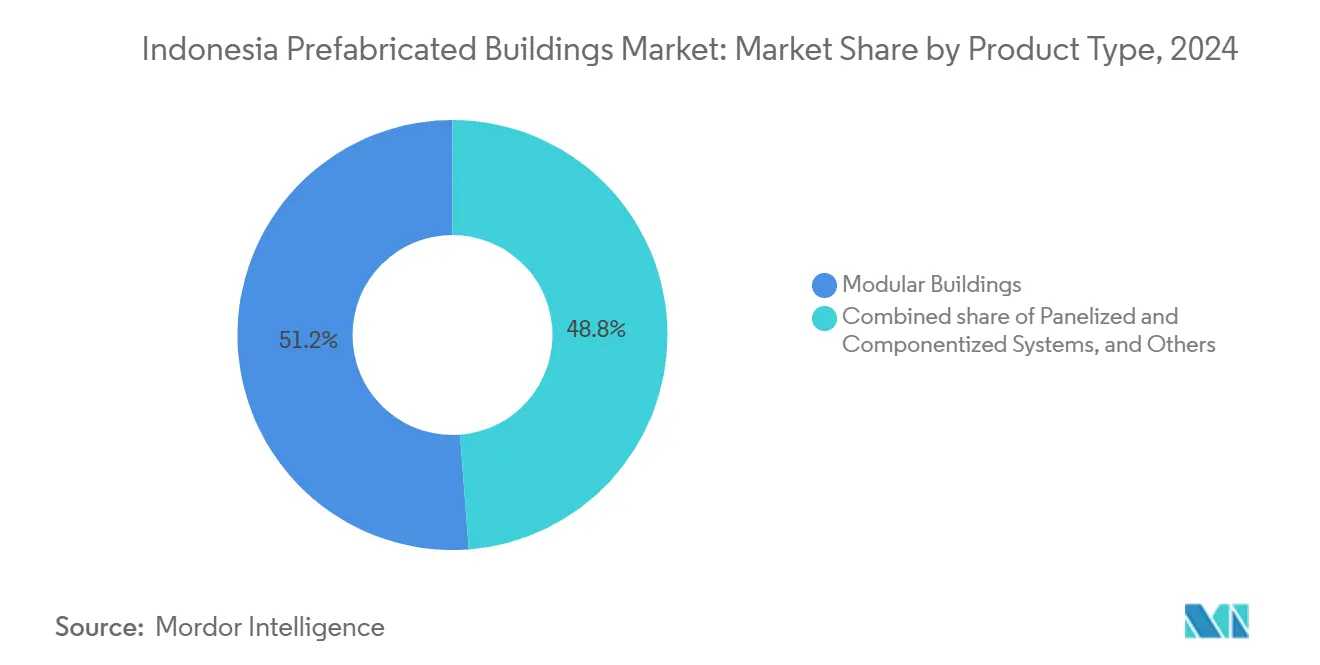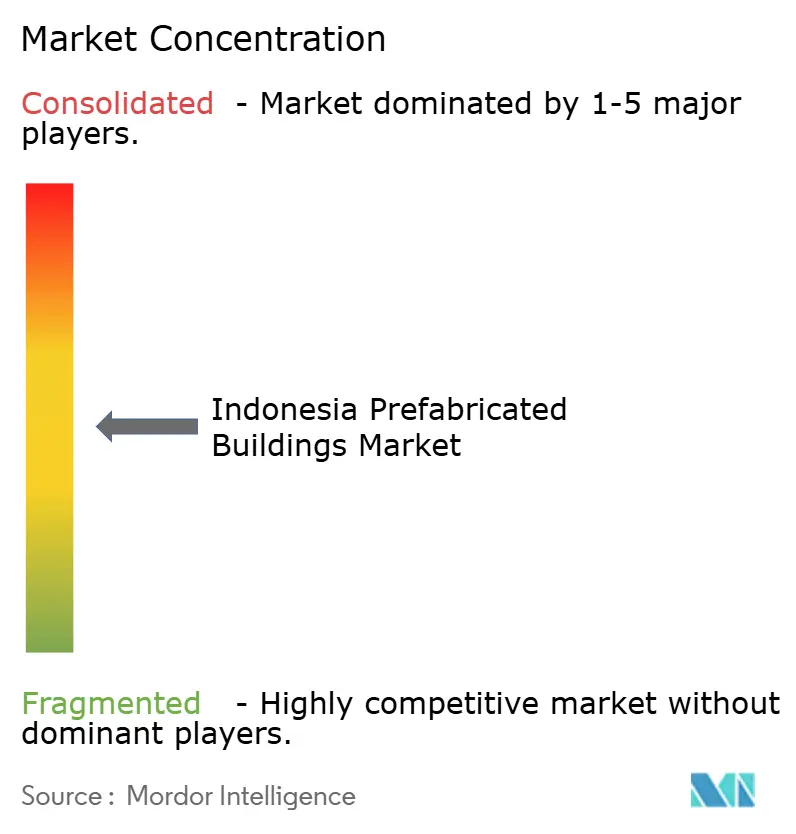
Indonesia Prefabricated Buildings Market Analysis by Mordor Intelligence
The Indonesia prefabricated buildings market size is estimated at USD 8.38 billion in 2025 and is expected to reach USD 11.9 billion by 2030 at a CAGR of 7.3% during the forecast period (2025-2030). Market momentum stems from the government’s decision to industrialize construction so it can clear a 9.9 million-unit housing backlog while meeting the infrastructure objectives set in the 2025–2029 national development plan[1]Indonesia.go.id, “Peta Jalan Wujudkan Hajat Hidup Layak bagi MBR,” Government of Indonesia, indonesia.go.id.
Rising allocations for public works, stronger private-sector participation, and greater adoption of modular technologies create a runway for sustained double-digit revenue growth in several high-value niches of the Indonesia prefabricated buildings market. President Prabowo Subianto’s “3 Million Homes” program establishes annual volume targets—2 million rural houses and 1 million urban apartments—that make factory production more economical than site-built methods, driving rapid order inflows for concrete, timber, and volumetric modules. At the same time, the Nusantara new capital project and offshore mining expansion broaden demand beyond residential, strengthening the multi-segment outlook for the Indonesia prefabricated buildings market.
Key Report Takeaways
- By material type, concrete captured 48.1% of the Indonesia prefabricated buildings market share in 2024. The timber segment is projected to grow at a 7.98% CAGR through 2030.
- By application, residential commanded 55.4% of the Indonesia prefabricated buildings market size in 2024, while commercial applications are advancing at a 7.61% CAGR to 2030.
- By product type, modular buildings held 51.2% revenue share of the Indonesia prefabricated buildings market in 2024 and lead growth at a 7.9% CAGR through 2030.
- By key cities, Jakarta led with a 22.2% share in 2024; the Rest of Indonesia is forecast to expand at an 8.12% CAGR through 2030.
Indonesia Prefabricated Buildings Market Trends and Insights
Drivers Impact Analysis
| Driver | (~) % Impact on CAGR Forecast | Geographic Relevance | Impact Timeline |
|---|---|---|---|
| One-Million Homes public housing push accelerating modular adoption | +1.8% | National, Java & Sumatra focus | Short term (≤ 2 years) |
| Skilled-labor gaps in eastern islands favoring off-site production | +1.2% | Maluku, Papua, Sulawesi | Medium term (2-4 years) |
| Nusantara new capital’s fast-track demand for worker accommodation | +1.5% | East Kalimantan | Short term (≤ 2 years) |
| Mandatory green-building rating spurs low-waste volumetric timber | +0.9% | Urban centers nationwide | Long term (≥ 4 years) |
| Offshore nickel-mining camps requiring rapid relocatable pods | +0.7% | Sulawesi & Maluku | Medium term (2-4 years) |
| Carbon-tax readiness driving industrialized net-zero construction | +0.6% | Major cities | Long term (≥ 4 years) |
| Source: Mordor Intelligence | |||
One-Million Homes Public Housing Push Accelerating Modular Adoption
The shift from the prior “One Million Homes” target to the ambitious “3 Million Homes” program alters the demand calculus in favor of prefabrication. Annual construction quotas surpass the capacity of traditional builders, prompting the Ministry of Public Works and Housing to fast-track standardized RISHA modules priced below IDR 8 million per unit to meet affordability thresholds. Middle-Eastern sovereign investors have pledged financing for up to 1 million units, importing volumetric methods refined in desert housing projects that reduce construction times by 30%-40% compared with in-situ techniques.
Confiscated land from corruption cases lowers acquisition costs, further strengthening the value proposition of the Indonesia prefabricated buildings market for public-sector buyers. Factory pre-installation of plumbing and electrical lines minimizes reliance on scarce site labor, allowing rural projects to proceed on schedule even during monsoon seasons.
Skilled-Labor Gaps in Eastern Islands Favoring Off-Site Production
Indonesia’s east-west labor imbalance has widened since 2024 as mega-projects shift outside Java. The Nusantara development alone needs roughly 300,000 construction workers, yet East Kalimantan can supply barely a third of that figure[2]The Jakarta Post, “New capital city development requires 300,000 construction workers,” thejakartapost.com. Prefabricated modules produced in Java travel by roll-on-roll-off vessels, arriving ready-to-assemble so local crews focus on anchoring and finishing rather than skilled trades. With national infrastructure spending set at IDR 422.7 trillion for 2024, contractors increasingly rely on modular methods to arbitrage labor costs between surplus regions and short-supply provinces, thereby sustaining orders for the Indonesia prefabricated buildings market.
Nusantara New Capital’s Fast-Track Demand for Worker Accommodation
The IDR 48.8 trillion 2025 allocation for Nusantara earmarks specific funding for worker dormitories, early civil-service housing, and government offices, requiring lightning-fast delivery timetables. Chinese firm Citic Construction will erect 60 residential towers using hybrid steel-concrete modules, demonstrating international confidence in Indonesia’s modular ecosystem. Green-forest-city mandates cap on-site waste and carbon intensity, giving an edge to prefabricated volumetric systems that generate 50% less waste than cast-in-place alternatives. Digital twins and BIM are integrated from design through commissioning, positioning the Indonesia prefabricated buildings market as a showcase for smart-city construction.
Mandatory Green-Building Rating Spurs Low-Waste Volumetric Timber
Regulation No. 21/2021 and local bylaws such as Jakarta’s Regulation 38/2012 compel new projects to earn green-building points, pushing developers toward low-embodied-carbon materials. Timber modules sequester carbon for decades and generate minimal off-cuts because CNC mills pre-cut each panel to ±2 mm tolerance. Academic trials on cross-laminated timber confirm resilience against zone-4 seismic loads, clearing a key engineering hurdle for medium-rise adoption. As the Indonesia Carbon Exchange matures, developers can monetize carbon savings, offsetting the 15% price premium of volumetric timber units. These factors widen the adoption window for the Indonesia prefabricated buildings market in urban high-performance segments.
Restraints Impact Analysis
| Restraint | (~) % Impact on CAGR Forecast | Geographic Relevance | Impact Timeline |
|---|---|---|---|
| Fragmented permitting across 38 provinces inflates compliance cost | -1.4% | Nationwide; outer islands hardest hit | Medium term (2-4 years) |
| High up-front factory CAPEX vs. volatile residential demand | -1.1% | Java & Sumatra industrial belts | Short term (≤ 2 years) |
| Limited domestic fire-testing facilities delaying multistory timber | -0.8% | Major urban centers | Long term (≥ 4 years) |
| Inter-island logistics premium on 12-meter modules | -0.9% | Eastern Indonesia & offshore sites | Medium term (2-4 years) |
| Source: Mordor Intelligence | |||
Fragmented Permitting Across 38 Provinces Inflates Compliance Cost
Regional autonomy leaves each province free to impose unique documentation, soil-test, and structural-review requirements. Processing times stretch from 14 days in streamlined districts to several months elsewhere, obliging manufacturers to tweak identical modules for differing local codes[3]International Journal of Scientific and Research Publications, “Activities in The Certificate of Occupancy Process…,” ijsrp.org. The National Standardization Agency issues SNI prefabrication standards, yet uneven enforcement forces companies to budget 3%-5% of project cost for compliance specialists. That drag tempers the addressable growth of the Indonesia prefabricated buildings market.
High Up-Front Factory CAPEX vs. Volatile Residential Demand
Modern volumetric lines cost USD 10-50 million; repayment hinges on steady multi-year order books. Yet mortgage-rate swings and shifting subsidy rules periodically stall housing launches, as seen in 2024 when residential building permits fell 8.6% year-on-year. Some producers run below 60% capacity during down-cycles, lengthening ROI horizons and deterring new entrants to the Indonesia prefabricated buildings market.
Segment Analysis
By Material Type: Concrete Dominance Faces Timber Innovation
Concrete retained 48.1% of Indonesia prefabricated buildings market share in 2024, reflecting mature supply chains, standardized molds, and robust precast codes. Heritage projects such as Jakarta’s MRT employed precast girders that set precedents for structural integrity and lifecycle cost, reinforcing developer confidence in concrete modules. The Indonesia prefabricated buildings market size for concrete solutions is positioned to expand steadily as public-works spending maintains high baseline volumes.
Timber, while accounting for a smaller slice, is growing fastest at a 7.98% CAGR to 2030. Carbon-tax scenarios modeled by the Ministry of Finance assign price pathways that make engineered timber par with reinforced concrete by 2027 on a whole-life-cost basis, accelerating investment in CLT mills. International hotel chains are piloting four-story timber lodges in Labuan Bajo, signaling wider commercial acceptance. Consequently, the Indonesia prefabricated buildings market will likely witness timber capture incremental points of market share each year through the decade.

By Application: Residential Scale Drives Commercial Innovation
Residential accounted for 55.4% of the Indonesia prefabricated buildings market size in 2024, underpinned by the “3 Million Homes” agenda and provincial subsidy schemes. RISHA concrete units and simple timber cabins make up the bulk of deliveries, often assembled by community cooperatives. This segment remains price-sensitive, favoring standardized designs that allow bulk procurement through e-catalogs managed by the National Public Procurement Agency.
Commercial builds—offices, hotels, data centers—present smaller but faster-expanding revenue pools. A 7.61% CAGR through 2030 reflects growing private capital inflows into logistics and tourism. Mines in Sulawesi now lease plug-and-play accommodation pods for USD 19 per bed per night, a model that improves cashflow visibility for manufacturers. As a result, commercial work is expected to capture a larger portion of Indonesia prefabricated buildings market share over the forecast horizon.
By Product Type: Modular Buildings Lead Integrated Solutions
Modular buildings held 51.2% of 2024 revenue and are forecast to post the highest CAGR at 7.9%. Factories now ship 95%-finished rooms complete with bathroom pods, conduits, and IoT sensors, cutting commissioning to as little as 15 days. PT Wijaya Karya reported an 8.4% gross-margin uptick in Q3 2024 by shifting from panelized supply toward end-to-end modular turnkey packages[4]WIKA, “Improved Operating Performance…,” wika.co.id. Consequently, the Indonesia prefabricated buildings market is pivoting to full volumetric formats, especially for government dormitories and mid-scale hotels.
Panelized and componentized systems keep traction where road clearances restrict box transport or where architects require bespoke facades. Hybrid steel-timber stacks now appear in coastal resorts, illustrating design latitude. Those niches sustain competition but will expand slower than the modular mainstay of the Indonesia prefabricated buildings market.

Geography Analysis
Jakarta contributed 22.2% of 2024 sales, anchored by transit-oriented apartment blocks and green‐retrofit mandates for office towers. Still, new capital spending is migrating eastward. The Rest of Indonesia segment is on track for an 8.12% CAGR, outpacing the overall Indonesia prefabricated buildings market as provincial governments fast-track ports, roads, and mining facilities in Sulawesi, Maluku, and Papua. Surabaya and Bandung leverage technical universities and industrial estates to seed local prefab clusters, reducing dependence on Jakarta suppliers and slashing delivery times by two weeks on average.
Decentralization also spurs competition among regional EPC firms, creating price tension that benefits public tenders but pressures margins. Over time, distributed factory networks should reduce logistics premiums, unlocking further penetration of the Indonesia prefabricated buildings market in remote provinces.
Competitive Landscape
The market is moderately fragmented, with state-owned giants PT Wijaya Karya and PT Hutama Karya leveraging sovereign credit lines to secure mega-projects. These firms often bundle EPC, financing, and facility management into a single tender. On the other hand, private players like PT Summarecon Prefab focus on higher-margin commercial constructions, utilizing agile design teams and imported robotic welding to reduce lead times. Partnerships with global innovators are becoming increasingly common: Citic Construction combines Chinese funding with volumetric expertise, while Japanese and Qatari investors collaborate to develop subsidized timber housing estates.
Competitive dynamics revolve around vertical integration, BIM proficiency, and ESG alignment. Companies adopting online IoT monitoring gain an edge by securing maintenance contracts that extend revenue beyond initial project delivery. Simultaneously, local steel fabricators are diversifying into turnkey pods to mitigate risks associated with commodity price fluctuations. These developments indicate that the Indonesian prefabricated buildings sector is likely to shift towards larger, technology-driven players over the next five years, although project-based procurement will continue to provide opportunities for specialized regional firms.
Indonesia Prefabricated Buildings Industry Leaders
PT Wijaya Karya (WIKA) Building
Kirby Building Systems
Bali Prefab
Superior Prima Sukses PT Tbk
PT Bukaka Teknik Utama Tbk
- *Disclaimer: Major Players sorted in no particular order

Recent Industry Developments
- March 2025: IKN Authority staff began working from Nusantara's completed office facilities, marking the operational commencement of Indonesia's new capital city and creating sustained demand for worker accommodation and government infrastructure projects.
- February 2025: PT Superior Prima Sukses Tbk invested approximately USD 167 million to build its fifth lightweight-brick factory in Banjarnegara, Central Java, with annual production capacity of 1 million m³, strengthening Indonesia's prefabricated building-materials supply chain.
- January 2025: PT Hutama Karya committed IDR 25.84 billion for sustainable-development programs in 2025, including construction of 15 educational facilities and support for 500 micro-enterprises, demonstrating state-owned enterprises' expanded role in prefabricated infrastructure delivery.
- August 2024: Sumitomo Forestry partnered with Sinarmas Land to develop approximately 4,100 residential units near Jakarta with USD 1.2 billion total investment, incorporating eco-friendly wooden structures and EDGE environmental certification.
Indonesia Prefabricated Buildings Market Report Scope
Prefabricated buildings, or prefabs, are buildings with components (walls, roof, and floor) that are manufactured in a factory or manufacturing plant. These components can be fully or partially assembled in a factory, and are then transferred to the construction site.
The Indonesian prefabricated buildings market is segmented by material type (concrete, glass, metal, timber, and other material types) and application (residential, commercial, and other applications [infrastructure and industrial]). The report offers the market size and forecasts in value (USD million) for the above segments.
| Concrete |
| Glass |
| Metal |
| Timber |
| Other Materials |
| Residential |
| Commercial |
| Others |
| Modular Buildings |
| Panelized & Componentized Systems |
| Other Prefab Types |
| Jakarta |
| Surabaya |
| Bandung |
| Medan |
| Rest of Indonesia |
| By Material Type | Concrete |
| Glass | |
| Metal | |
| Timber | |
| Other Materials | |
| By Application | Residential |
| Commercial | |
| Others | |
| By Product Type | Modular Buildings |
| Panelized & Componentized Systems | |
| Other Prefab Types | |
| By Key Cities | Jakarta |
| Surabaya | |
| Bandung | |
| Medan | |
| Rest of Indonesia |
Key Questions Answered in the Report
What is the current value of the Indonesia prefabricated buildings market?
The market is valued at USD 8.38 billion in 2025 and is forecast to reach USD 11.9 billion by 2030.
How fast is the sector growing?
It is expanding at a 7.3% CAGR over the 2025–2030 period, underpinned by large-scale housing and infrastructure programs.
Which product type is gaining the most traction?
Fully integrated modular buildings lead sales with 51.2% share in 2024 and exhibit the highest 7.9% CAGR through 2030.
Why is timber prefabrication becoming more popular?
Mandatory green-building rules and looming carbon taxes enhance the cost competitiveness of engineered timber, driving a 7.98% CAGR for the segment.
What role does the Nusantara new capital project play?
Nusantara is accelerating demand for rapid-deployment worker housing and government offices, boosting order books for modular suppliers.



